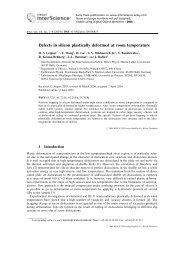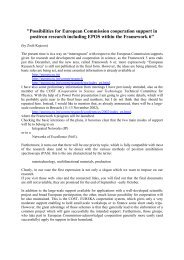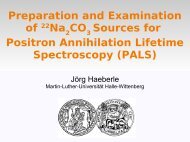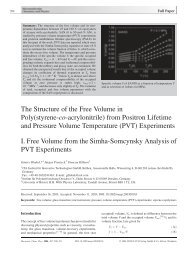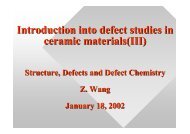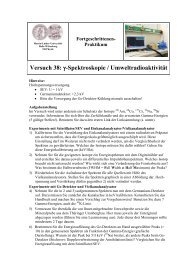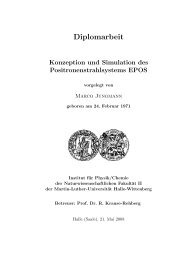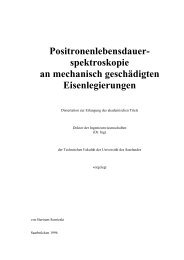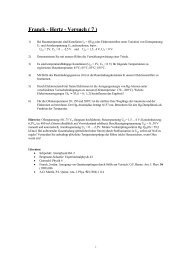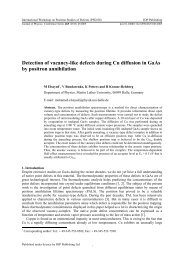V - Positron Annihilation in Halle
V - Positron Annihilation in Halle
V - Positron Annihilation in Halle
You also want an ePaper? Increase the reach of your titles
YUMPU automatically turns print PDFs into web optimized ePapers that Google loves.
Defect Characterization <strong>in</strong> Crystall<strong>in</strong>e y Solids<br />
R. Krause-Rehberg<br />
Univ. <strong>Halle</strong><br />
• Why are nano-defects important at all?<br />
• Defects <strong>in</strong> metals and semiconductors<br />
• <strong>Positron</strong> beam applications<br />
Mart<strong>in</strong>-Luther-Universität RK<br />
<strong>Halle</strong><br />
R
Po<strong>in</strong>t defects determ<strong>in</strong>e properties of materials<br />
Galliumphosphide<br />
• Po<strong>in</strong>t defects determ<strong>in</strong>e<br />
electronic and optical<br />
properties<br />
without vacancies with 00.001% 001% vacancies<br />
• electric conductivity<br />
strongly <strong>in</strong>fluenced<br />
transparent opaque<br />
1 vacancy <strong>in</strong> 100000 atoms<br />
• Po<strong>in</strong>t defects are generated by irradiation, by plastic deformation or by<br />
diffusion, …<br />
• Metals <strong>in</strong> high radiation environment -> > formation of voids -> > embrittlement<br />
• -> Properties of vacancies and other po<strong>in</strong>t defects must be known<br />
• Analytical tools are needed to characterize po<strong>in</strong>t defects<br />
Mart<strong>in</strong>-Luther-Universität <strong>Halle</strong><br />
1 cm
• Vacancy concentration <strong>in</strong><br />
thermal equilibrium:<br />
• <strong>in</strong> metals H F 1...4 eV <br />
at T m [1v] 10 -4...-3 /atom<br />
• fits well to the sensitivity<br />
range of positron annihilation<br />
(Ziegler, 1979)<br />
Mart<strong>in</strong>-Luther-Universität <strong>Halle</strong><br />
Vacancies <strong>in</strong> thermal Equilibrium<br />
meter<br />
W param<br />
Tungsten<br />
H F = (4.0 0.3) eV<br />
temperature (K)<br />
fit to trapp<strong>in</strong>g model
Defects <strong>in</strong> Iron after tensile strength and fatigue treatment<br />
• extensive i study d of f defects d f <strong>in</strong> i mechanically h i ll ddamaged d i iron and d steel l<br />
• <strong>Positron</strong>s are very sensitive: detection of defects already <strong>in</strong> the Hooks range of the<br />
stress-stra<strong>in</strong> experiment<br />
• Vacancy cluster and dislocations are detectable <strong>in</strong> both cases<br />
Mart<strong>in</strong>-Luther-Universität <strong>Halle</strong><br />
Somieski et al., J. Physique IV 5, C1/127-134 (1995)
Defects <strong>in</strong> electron-irradiated electron irradiated Ge<br />
• Electron irradiation (2 MeV @ 4K) <strong>in</strong>duces Frenkel pairs (vacancy - <strong>in</strong>terstitial pairs)<br />
• steep anneal<strong>in</strong>g stage at 200 K<br />
• at high irradiation dose: divacancies are formed (thermally stable up to 400 K)<br />
(Polity et al., 1997)<br />
Mart<strong>in</strong>-Luther-Universität <strong>Halle</strong><br />
GGe<br />
e - irr. at 4K
Electron irradiation of Si<br />
• low-temperature electron irradiation<br />
was performed at 4K (Ee-=2 MeV)<br />
• anneal<strong>in</strong>g stage of monovacancies at<br />
about 170 K<br />
• mov<strong>in</strong>g V Si partly form divacancies<br />
• divacancies anneal at about 550…650 K<br />
Mart<strong>in</strong>-Luther-Universität <strong>Halle</strong><br />
PPolity lit et t al., l Ph Phys. RRev. B 58 (1998) 10363
GaAs: anneal<strong>in</strong>g under def<strong>in</strong>ed As As-partial partial pressure<br />
• two-zone-furnace: Control of sample<br />
temperature and As partial pressure<br />
allows to navigate freely <strong>in</strong> phase<br />
diagram (existence area of compound)<br />
• Measurements near equilibrium after<br />
quench<strong>in</strong>g of samples<br />
T Tsample: l : 1100 1100° C T d t i A H W l t l J C t G th 109 191 (1991)<br />
As: determ<strong>in</strong>es Aspartial<br />
pressure<br />
Mart<strong>in</strong>-Luther-Universität <strong>Halle</strong><br />
H. Wenzl et al., J. Cryst. Growth 109, 191 (1991).
ation (cm -3 Vacanccy<br />
concentra )<br />
10 17<br />
GaAs: Anneal<strong>in</strong>g under def<strong>in</strong>ed As pressure<br />
Si Ga-V Ga<br />
GaAs:Si<br />
L<strong>in</strong>ear fit<br />
001 0,01 01 0,1 1 10<br />
Arsenic pressure (bar)<br />
Thermodynamic reaction:<br />
1/4 As gas<br />
4 ↔ AsAs As As + V Ga<br />
Mass action law:<br />
[V [VG ] = KVG × p 1/4<br />
Ga] KVG × pAAs Mart<strong>in</strong>-Luther-Universität <strong>Halle</strong><br />
tration (cm )<br />
-3 Vacanncy<br />
concent )<br />
10 18<br />
10 17<br />
10<br />
10 16<br />
-3<br />
[T [Te] ] <strong>in</strong> i cm -3<br />
6x10 18<br />
2x10 18<br />
17<br />
4x10 17<br />
9x10 16<br />
GaAs:Te<br />
Te As-V Ga<br />
0,1 1 10<br />
Arsenic pressure (bar)<br />
Fit: [V Ga-Dopant] ~ p As n<br />
→ n = 1/4<br />
250<br />
245<br />
240<br />
235<br />
231<br />
K (ps)<br />
τ at 550 K<br />
av<br />
J. Gebauer et al.,<br />
Physica y B 273-274, 705 (1999) ( )
Comparison of doped and undoped GaAs<br />
Bondarenko et al., 2003<br />
Mart<strong>in</strong>-Luther-Universität <strong>Halle</strong><br />
Thermodynamic y reaction:<br />
As As ↔ VAs + 1/4As gas<br />
4<br />
Mass action law:<br />
[V As] = K VAs × p As -1/4<br />
Fit: [V-complex] [V complex] ~ p n<br />
As<br />
→ n = -1/4<br />
undoped GaAs: As vacancy
Vacancy clusters <strong>in</strong> semiconductors<br />
• vacancy clusters were observed after ion/neutron irradiation, ion<br />
implantation and plastic deformation<br />
• due to lar large e open volume (low electron density) -> > positron lifetime<br />
<strong>in</strong>creases dist<strong>in</strong>ctly<br />
• example: plastically deformed Ge<br />
• lifetime: τ = 525 ps<br />
• reason for void formation: jog<br />
dragg<strong>in</strong>g mechanism<br />
• trapp<strong>in</strong>g rate of voids disappears<br />
dur<strong>in</strong>g anneal<strong>in</strong>g experiment<br />
Mart<strong>in</strong>-Luther-Universität <strong>Halle</strong><br />
Krause-Rehberg et al., 1993
Theoretical Calculation of Vacancy Clusters <strong>in</strong> Si<br />
Mart<strong>in</strong>-Luther-Universität <strong>Halle</strong><br />
• there are cluster configurations<br />
with a large energy ga<strong>in</strong><br />
• „Magic Magic Numbers“ Numbers with 6, 6 10 und<br />
14 vacancies<br />
• positron lifetime <strong>in</strong>creases<br />
dist<strong>in</strong>ctly with cluster size<br />
• for n > 10 saturation effect, i.e.<br />
size cannot be determ<strong>in</strong>ed<br />
T.E.M. Staab et al.,<br />
Physica B 273-274 (1999) 501-504
Height H [nm] ]<br />
02 0.2<br />
0.1<br />
0.0<br />
Identification of V VGa Ga-Si SiGa Ga-Complexes Complexes <strong>in</strong> GaAs:Si<br />
occupied empty states<br />
-2.0 V +1.4 V<br />
1 2 3 4 5 6 7 8 9 1 2 3 4 5 6 7 8 9<br />
lattice spac<strong>in</strong>g <strong>in</strong> [110] direction<br />
• Scann<strong>in</strong>g tunnel<strong>in</strong>g microscopy at GaAs (110)-<br />
cleavages l planes l (by (b Ph Ph. Ebert, Eb t Jülich) Jüli h)<br />
• Defect complex identified as VGa-SiGa Mart<strong>in</strong>-Luther-Universität <strong>Halle</strong><br />
cm -3 Defect<br />
conceentration<br />
(c )<br />
10 19<br />
10 19<br />
10 18<br />
10 17<br />
10 18<br />
<strong>Positron</strong>s - c vac<br />
STM - [Si Ga -V Ga ]<br />
10 19<br />
Si concentration (cm -3 )<br />
• Quantification → Agreement<br />
Mono-Vacancies <strong>in</strong> GaAs:Si are V Ga- Si Ga-complexes<br />
Gebauer et al., Phys. Rev. Lett. 78 (1997) 3334
Defects after high energy Si self self-implantation<br />
implantation -the the Rp/2 Effect<br />
on (cm -3 Cu conncentratio<br />
)<br />
• After high-energy self-implantation of Si (3.5 MeV; 5 ×10<br />
2 15 cm -2 ) and RTA (900°C, 30s): two<br />
new getter zones appear at Rp and Rp /2 (Rp = projected range of Si + )<br />
• Zones become visible after Cu <strong>in</strong>-diffusion from rear side of sample (Cu implantation and<br />
diffusion anneal<strong>in</strong>g at 600°C)<br />
10 17<br />
10 16<br />
TEM image by P. Werner, MPI <strong>Halle</strong><br />
SIMS<br />
10<br />
0 1 2 3 4<br />
15<br />
Mart<strong>in</strong>-Luther-Universität <strong>Halle</strong><br />
R p/2<br />
DDepth th( (μm)<br />
)<br />
R p<br />
• at Rp : getter<strong>in</strong>g by <strong>in</strong>terstitial type<br />
dislocation loops<br />
• Formed due to <strong>in</strong>terstial excess Si after<br />
iimplantation l t ti and dRTA RTA anneal<strong>in</strong>g li<br />
• Although getter<strong>in</strong>g appears, no defects<br />
visible by TEM at Rp /2<br />
• What is the nature of these defects?
positron<br />
lifetime (pss)<br />
Improved depth resolution by us<strong>in</strong>g a positron microbeam<br />
τ defect<br />
τ bulk<br />
positron<br />
microbeam<br />
E = 8 keV<br />
• We used Munich positron<br />
microscope p<br />
• Sample polished wedge-like<br />
scan direction (wedge angle 0.5…2°)<br />
• Defect depth profile of 10 µm<br />
μ<br />
α = 0.6° lateral resolution<br />
1 ... 2 μm<br />
becomes as long as 1 mm<br />
• Thus, depth resolution con be<br />
optimized by wedge angle<br />
defect depth<br />
10 m<br />
Mart<strong>in</strong>-Luther-Universität <strong>Halle</strong><br />
0 1 mm<br />
scan width
First defect-depth defect depth profile us<strong>in</strong>g a<br />
0,6<br />
positron microprobe<br />
0,4<br />
• 45 lifetime spectra were recorded along<br />
wedge d<br />
• Because of beam diameter - depth resolution<br />
of 155 nm is obta<strong>in</strong>ed at α = 0.81°<br />
• <strong>Positron</strong> implantation energy: 8 keV ⇒ mean<br />
<strong>in</strong>formation depth 400 nm<br />
• OOptimum i ddepth h resolution l i<br />
• Both defected regions well visible<br />
• Vacancy clusters with <strong>in</strong>creas<strong>in</strong>g density<br />
down to 2 µm (Rp/2 region)<br />
• At R p region: lifetime τ2 = 330 ps; open<br />
volume corresponds to a divacancy; must<br />
be stabilized or be<strong>in</strong>g part of dislocation<br />
loops<br />
R. Krause-Rehberg et al., Appl. Phys. Lett. 77 (2000) 3932<br />
Mart<strong>in</strong>-Luther-Universität <strong>Halle</strong><br />
η<br />
τ 2 (ps)<br />
averagee<br />
lifetime (ps) (<br />
0,8<br />
450<br />
400<br />
350<br />
380<br />
360<br />
340<br />
320<br />
300<br />
260<br />
0 1 2 3 4 5 6<br />
microvoids<br />
R p /2 R p<br />
fraction of<br />
trapped positrons<br />
defect-related<br />
lifetime<br />
divacancy-type<br />
defect<br />
Silicon self-implantation<br />
- 3.5 MeV, 5×10 15 cm -2<br />
- annealed 30s 900°C<br />
- Cu contam<strong>in</strong>ated<br />
Cu SIMS-Profil<br />
280 surface bulk silicon<br />
0 1 2 3 4 5 6<br />
ddepth th( (µm) )
Diffusion of Cu <strong>in</strong> GaAs<br />
280<br />
• <strong>Positron</strong> experiment:<br />
• 30 nm Cu-layer deposited by<br />
•<br />
evaporation evapo at o<br />
Anneal<strong>in</strong>g at 1100°C (under def<strong>in</strong>ed<br />
270<br />
•<br />
•<br />
As-pressure) for Cu <strong>in</strong>-diffusion<br />
Quench<strong>in</strong>g to RT<br />
then anneal<strong>in</strong>g with grow<strong>in</strong>g<br />
260<br />
•<br />
temperature<br />
<strong>Positron</strong> lifetime measurement<br />
250<br />
• Cu is completely solved at 1100°C<br />
• But it is oversaturated at RT<br />
• Precipitation starts very slowly (slow<br />
diffusion)<br />
• However: at elevated temperatures – diffusion<br />
240<br />
bbecomes faster: f out-diffusion diff i process<br />
• Result: formation of vacancy-type defects<br />
when out-diffusion starts<br />
• Not compatible with ith current c rrent diffusion diff sion models<br />
230<br />
Mart<strong>in</strong>-Luther-Universität <strong>Halle</strong><br />
averrage<br />
positrron<br />
lifetimee<br />
(ps)<br />
400 K<br />
500 K<br />
550 K<br />
600 K<br />
650 K<br />
700 K<br />
750 K<br />
800 K<br />
850 K<br />
900 K<br />
0 100 200 300 400 500<br />
measurement temperature (K)
Determ<strong>in</strong>ation of Defect Type 280<br />
• Formation of these clusters is almost<br />
<strong>in</strong>dependent of dop<strong>in</strong>g / conduction type<br />
• Identical behavior <strong>in</strong> undoped p GaAs<br />
• In beg<strong>in</strong>n<strong>in</strong>g of defect formation: defectrelated<br />
lifetime is about 250 ps – a<br />
monovacancy<br />
• In course of anneal<strong>in</strong>g: lifetime growth to<br />
averagee<br />
lifetime (pps)<br />
defect-relaated<br />
lifetime (pps)<br />
270<br />
260<br />
250<br />
240<br />
230<br />
500<br />
450<br />
400<br />
350<br />
300<br />
320-350 ps correspond<strong>in</strong>g to a divacancy 250<br />
• at 800 K: τ 2 > 450 ps: rather large vacancy<br />
clusters (n > 10)<br />
Mart<strong>in</strong>-Luther-Universität <strong>Halle</strong><br />
<strong>in</strong>tensitty<br />
I2 1,0<br />
05 0,5<br />
0,0<br />
undoped GaAs<br />
GaAs:Te<br />
measurement temperature: 466 K<br />
500 600 700 800 900<br />
anneal<strong>in</strong>g temperature (K)
Voids <strong>in</strong> GaAs<br />
• Molecular-dynamic cluster<br />
calculations give energy ga<strong>in</strong><br />
compared to sum of monovacancies<br />
• Relaxation was taken <strong>in</strong>to account<br />
• Energetically favored: 12 vacancies<br />
• <strong>Positron</strong> lifetime was calculated<br />
• stable 12-atom cluster exhibit positron<br />
lifetime of about 450 ps<br />
• Found <strong>in</strong> experiment<br />
Mart<strong>in</strong>-Luther-Universität <strong>Halle</strong><br />
TEM Staab et al., Physica B 273-274 (1999) 501-504
Co<strong>in</strong>cidence<br />
Co<strong>in</strong>cidence-Doppler Doppler Spectroscopy at GaAs:Cu<br />
• In high-momentum region (>10-2 2<br />
m m0c) c) annihilation with Coreelectrons<br />
dom<strong>in</strong>ate<br />
0<br />
• Electron momentum distribution of<br />
core electrons almost not changed<br />
compared to <strong>in</strong>dividual atoms<br />
1,00<br />
• Rlti Relatively l easy to t calculate l lt<br />
• In example: the detected vacancies<br />
have Cu atoms <strong>in</strong> closest vic<strong>in</strong>ityy 075 0,75<br />
• Vacancies are obviously stabilized<br />
by Cu<br />
Mart<strong>in</strong>-Luther-Universität <strong>Halle</strong><br />
Raatio<br />
to bulkk<br />
GaAs<br />
4<br />
Cu<br />
V Ga -Si Ga<br />
SI-GaAs:Cu (annealed, at 500 K)<br />
SI-GaAs:Cu (as quenched, at 30 K)<br />
0 10 20<br />
p (10 L<br />
30<br />
-3 m c) 0<br />
V. Bondarenko, K. Petters, R. Krause Krause-Rehberg, Rehberg, J. Gebauer, H.S. Leipner,<br />
Physica B 308-310 (2001)792-795
Conclusions<br />
• <strong>Positron</strong>s are a useful tool<br />
• For characterization of vacancy-type defects <strong>in</strong> crystall<strong>in</strong>e solids<br />
• Unique for mono-vacancies<br />
• V Very sensitive iti for f vacancy clusters l t for f n < 10 (below (b l TEM sensitivity) iti it )<br />
• Sensitivity limit for monovacancies ≈ 10 15 /ccm<br />
R. Krause-Rehberg, H.S. Leipner<br />
„<strong>Positron</strong> <strong>Annihilation</strong> <strong>in</strong> Semiconductors“<br />
Spr<strong>in</strong>ger Spr<strong>in</strong>ger-Verlag, Verlag 1999



